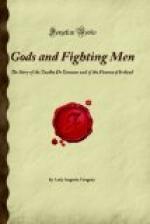The whole problem is extremely complex, and several other writers have written upon it. Mr Borlase, for instance, has argued in his big book on the Dolmens that the cromlechs, and presumably the Diarmuid and Crania legend, is connected with old religious rites of an erotic nature coming down from a very primitive state of society.
I have come to my own conclusion not so much because of any weight of argument, as because I found it impossible to arrange the stories in a coherent form so long as I considered them a part of history. I tried to work on the foundation of the Annalists, and fit the Fianna into a definite historical epoch, but the whole story seemed trivial and incoherent until I began to think of them as almost contemporaneous with the battle of Magh Tuireadh, which even the Annalists put back into mythical ages. In this I have only followed some of the story-tellers, who have made the mother of Lugh of the Long Hand the grandmother of Finn, and given him a shield soaked with the blood of Balor. I cannot think of any of the stories as having had a modern origin, or that the century in which each was written down gives any evidence as to its age. “How Diarmuid got his Love-Spot,” for instance, which was taken down only a few years ago from some old man’s recitation by Dr Hyde, may well be as old as “Finn and the Phantoms,” which is in one of the earliest manuscripts. It seems to me that one cannot choose any definite period either from the vast living mass of folk-lore in the country or from the written text, and that there is as good evidence of Finn being of the blood of the gods as of his being, as some of the people tell me, “the son of an O’Shaughnessy who lived at Kiltartan Cross.”
Dr Douglas Hyde, although he placed the Fenian after the Cuchulain cycle in his History of Irish Literature, has allowed me to print this note:—
“While believing in the real objective existence of the Fenians as a body of Janissaries who actually lived, ruled, and hunted in King Cormac’s time, I think it equally certain that hundreds of stories, traits, and legends far older and more primitive than any to which they themselves could have given rise, have clustered about them. There is probably as large a bulk of primitive mythology to be found in the Finn legend as in that of the Red Branch itself. The story of the Fenians was a kind of nucleus to which a vast amount of the flotsam and jetsam of a far older period attached itself, and has thus been preserved.”
As I found it impossible to give that historical date to the stories, I, while not adding in anything to support my theory, left out such names as those of Cormac and Art, and such more or less historical personages, substituting “the High King.” And in the “Battle of the White Strand,” I left out the name of Caelur, Tadg’s wife, because I had already followed another chronicler in giving him Ethlinn for a wife. In the earlier part I have given back to Angus Og the name of “The Disturber,” which had, as I believe, strayed from him to the Saint of the same name.




